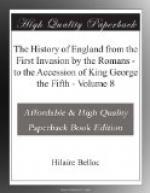Edward Earle of Glamorgan.”
Some writers have attempted to dispute the authenticity of this warrant, because though it was inserted verbatim in Glamorgan’s treaty with the confederates, he did not produce it at the requisition of the council at Dublin, under the excuse that he had deposited it with the Catholics at Kilkenny. But that this was the truth, appears from the Nuncio’s Memoirs: “a sua majestate mandatum habuit, cujus originate regia manu subscriptum Glamorganae comes deposuit apud confoederatos Catholicos,” (fol. 1292, apud Birch, 215); and if better authority be required, I have in my possession the original warrant itself, with the king’s signature and private seal, bearing the arms of the three kingdoms, a crown above, and C.R. on the sides, and indorsed in the same handwriting with the body of the warrant, “The Earle of Glamorgan’s espetiall warrant for Ireland.” Of this original the above is a correct copy.
April 30. The king having heard that Rinuccini had been appointed nuncio, and was on his way to Ireland, sent to Glamorgan a letter for that prelate and another for the pope. The contents of the second are unknown; the first is copied in the Nuncio’s Memoirs, “Nous ne doubtons point, que les choses n’yront bien, et que les bonnes intentions commences par effect du dernier pape ne s’accomplisseront par celuys icy, et par vos moyens, en notre royaume d’Irelande et de Angleterre.”—Birch 28. He then requests the nuncio to join with Glamorgan, and promises to accomplish on the return of the latter, whatever they shall have resolved together.—Ibid.
The king, on his return to Oxford, after the disastrous campaign of 1645, still placed his principal reliance on the mission of Glamorgan; and, to induce the court of Rome to listen to the proposals of that envoy, wrote, with his own hand, the two following letters, of which the originals still exist in the Archivio Vaticano, one to the pope himself, the other to Cardinal Spada, requesting of both to give credit to Glamorgan or his messenger, and engaging the royal word to fulfil whatever should be agreed upon by Glamorgan, in the name of his sovereign:—
“BEATISSIME PATER,
“Tot tantaque testimonia fidelitatis et affectus consanguinei nostri comitis Glamorganiae jamdudum accepimus, eamque in illo fiduciam merito reponimus, ut Sanctitas Vestra ei fidem merito praebere possit in quacumque re, de qua per se vel per alium nostro nomine cum Sanctitate Vestra tractaturus sit. Quaecumque vero ab ipso certo statuta fuerint, ea munire et confirmare pollicemur. In cujus testimonium brevissimas has scripsimus, manu et sigillo nostro munitas, qui nihil (potius) habemus in votis, quam ut fevore vestro in eum statum redigamur, quo palam profiteamur nos.
“Sanctitatis Vestrae
“Humilimum et obedientissimum servum,
“Apud Curiam nostram,
CHARLES R.
Oxoniae, Oct. 20, 1645.”
Superscription—




